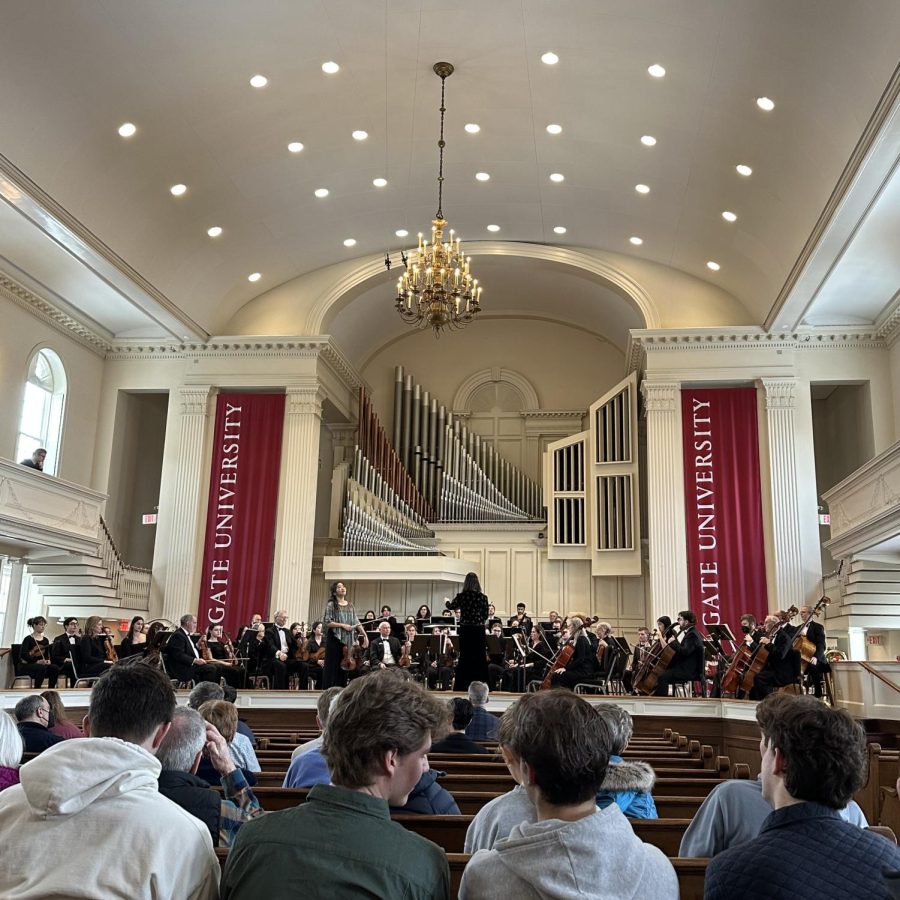Bringing the Drama: Orchestra Performs with Violinist Kristin Lee
The Colgate University Orchestra, conducted by Director Marietta Cheng, performed Sibelius’s Symphony No. 2 in D Major, OP. 43, as well as Verdi’s Overture to Luisa Miller and Max Bruch’s Violin Concerto No. 1 in G minor, on Sunday, Feb. 26 in the Colgate Memorial Chapel. The orchestra accompanied violinist Kristin Lee, the featured soloist, in her rendition of the Bruch piece.
Lee has performed with Cheng at Colgate periodically throughout her career.
“I love coming out to Colgate. This is, I believe, my sixth or seventh visit, so [I’m] very familiar with the beautiful campus and it’s always great to see familiar faces, and also the new faces,” Lee said. “I’m just really excited to be working with [Cheng]. My friendship with her is what’s most special to me, and I’m so appreciative of her inviting me to come back. Just getting to see her and work with her again — especially because this piece is the very first piece we played together over a decade ago — I’m really excited to be revisiting that.”
Lee has has built an impressive career across the musical field. She has received a number of accolades for her work, including the 2015 Avery Fisher Career Grant, and she recently joined the faculty of the University of Cincinnati College-Conservatory of Music.
Her performance was animated and intense; the music energetically flowed from her violin. Time slowed down as she played, and the audience and orchestra appeared united in awe. Sophomore Julian Dalziel, a violist in the Colgate University Orchestra, said he was blown away by Lee’s skill.
“I have no idea how she did that, there are so many running lines an — more than anything — it’s really hard to play all those notes, but [Lee] also actually, she had movement within it too, which was impressive,” Dalziel said. “She kind of told a story. [Performing like that is] also exhausting. It’s so tiring.”
The event began with the Verdi Overture, followed by the Bruch and then the Sibelius Symphony. The Sibelius composition was the longest piece, showcasing the Orchestra and Cheng’s clear mastery of musical storytelling.
“All symphonies…start off with the first section, which is kind of like your pilot, so they feature what’s going to happen and they kind of like go through the main themes,” Dalziel said. “And then in the second section, it breaks down. This is usually the slowest section. The third builds back up to the finale.”
He continued, “the opening to the Sibelius is kind of structured in four parts because it’s a symphony. It’s cool to play because you can really juice the sound in the fourth movement and make it sound really powerful, and it’s really cool to be sitting there [feeling the horns] in your back and you can hear all the strings around you.”
The performances were impressive, with a full sound and clear grandeur. Dalziel described the purposeful arrangement of the music.
“I feel like all the pieces usually there’s some sort of theme… these were all supposed to be [dramatic] songs,” Dalziel said. “The intensity in the Verdi is the chord progression from… [C] minor to major, [which] starts off sad and then it resolves itself, same sort of idea with the Sibelius.”
After listening to the performances, sophomore Zach Greenberg remarked on the emotional power of the music.
“I found it extremely therapeutic,” Greenberg commented. “The main violinist and guest performer, she basically painted a story with the violin and I could really feel and see the music.”

LJ Coady is a junior from Houston, TX concentrating in political science with minors in history and religion. She has previously served as a writer for...









